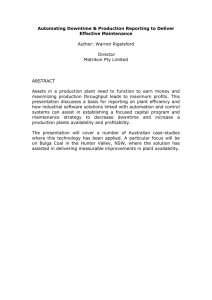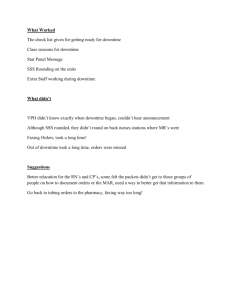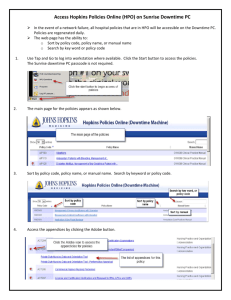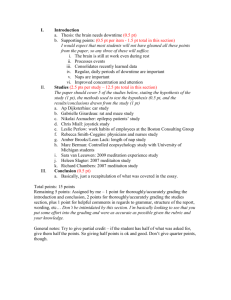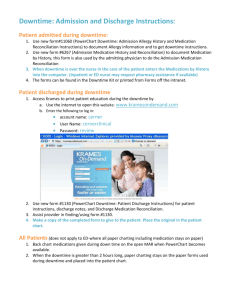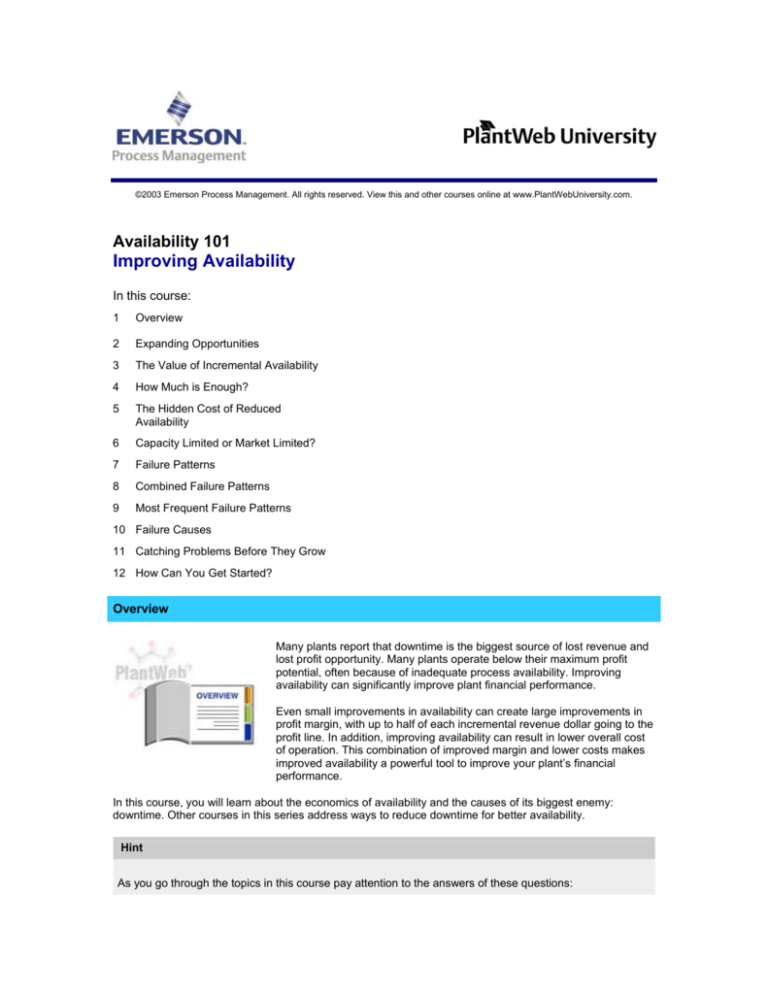
©2003 Emerson Process Management. All rights reserved. View this and other courses online at www.PlantWebUniversity.com.
Availability 101
Improving Availability
In this course:
1
Overview
2
Expanding Opportunities
3
The Value of Incremental Availability
4
How Much is Enough?
5
The Hidden Cost of Reduced
Availability
6
Capacity Limited or Market Limited?
7
Failure Patterns
8
Combined Failure Patterns
9
Most Frequent Failure Patterns
10 Failure Causes
11 Catching Problems Before They Grow
12 How Can You Get Started?
Overview
Many plants report that downtime is the biggest source of lost revenue and
lost profit opportunity. Many plants operate below their maximum profit
potential, often because of inadequate process availability. Improving
availability can significantly improve plant financial performance.
Even small improvements in availability can create large improvements in
profit margin, with up to half of each incremental revenue dollar going to the
profit line. In addition, improving availability can result in lower overall cost
of operation. This combination of improved margin and lower costs makes
improved availability a powerful tool to improve your plant’s financial
performance.
In this course, you will learn about the economics of availability and the causes of its biggest enemy:
downtime. Other courses in this series address ways to reduce downtime for better availability.
Hint
As you go through the topics in this course pay attention to the answers of these questions:
What are the financial opportunities for improving my availability?
What are the causes of downtime?
What are the various failure patterns and how can understanding them help me reduce my
downtime?
Availability measures generally do not indicate if production is at required quality, optimum cost or target
throughput levels. Although these factors are important, they are the subjects of other courses at PlantWeb
University.
Expanding Opportunities
Availability is typically defined as a percentage of scheduled production time—which excludes planned
downtime for maintenance or other purposes.
For example, consider a facility that has an actual production time of 8000 hours per year and a scheduled
shutdown of two weeks per year.
Availability = Actual production time / Scheduled production time
= 8000 / ((365-14) * 24)
= 95%
Most people only look for increased availability opportunity up to the limit of scheduled production—for
example, by reducing unplanned downtime. But suppose you could also reduce planned downtime, by
having fewer and shorter scheduled shutdowns, or starting up faster afterwards?
You’d open up new opportunities for increasing availability. And the higher the availability, the greater your
return on assets.
The Value of Incremental Availability
The value of increased availability is usually underestimated.
If plant revenue is $100 million per year, each incremental hour of production is worth $11,400. At that rate,
trimming one week from a planned shutdown would deliver a revenue improvement of almost $2,000,000.
If the variable cost of production is 50% of revenue, and operating profit is 10%, most people would
calculate the profit potential as 10% of $2,000,000, or $200,000. This dramatically understates the profit
value of incremental availability.
That is because fixed costs are based on existing production hours. An hour of incremental production
doesn't increase fixed cost, so the profit component of an hour of incremental production is actually
incremental revenue minus variable cost.
In the example plant, the profit margin on the incremental production time is 50%, and $2,000,000 of
increased revenue actually delivers $1,000,000 of incremental profit. Thus, it's important to consider the
profit impact of increased availability, not just the revenue increase.
Before
After
How Much is Enough?
Even the best plants have some downtime. What makes them the best is keeping availability as high as
possible. In fact, when major operational drivers such as productivity, feedstock costs, fuel or energy costs,
emissions compliance, and waste disposal costs are taken into account, availability is the factor that differs
most between the worst- and best-performing plants. That difference covers a span from as low as 72%
availability to as high as 95%.
As the table shows, 75% of the process industry has availability 4% or more below best practices.
Recapturing this lost production can increase revenue by 4%.
Fluor Global Services – Benchmark Study – NA, AP, EU, 1996.
Incremental profit = Incremental Revenue — Variable Cost of Production
If variable cost is 50% of revenue, profit on this incremental production is half of 4%, or 2% of revenue.
Where throughput is capacity limited, 75% of the process industry has the potential to gain 2% of annual
revenue as incremental profit by improving availability to best practices levels.
The Hidden Cost of Reduced Availability
Poor availability can also increase capital cost, which increases fixed costs.
A major worldwide refiner estimated that 10% of their total worldwide production capacity was in place just to
cover production losses due to unscheduled downtime. This means their fixed cost for depreciation will be
10% higher because of the unscheduled downtime.
If you have multiple process trains, or multiple facilities to meet market demand, your capital investment may
be higher than required. Poor availability may be driving you to increase capital investment so you have
enough capacity to meet demand if part of your production capacity is experiencing unscheduled downtime.
Downtime may also force you to increase finished goods inventory so you can meet demand during a period
of downtime.
Capacity Limited or Market Limited?
It is important to understand that the economics of availability are different depending on whether you are
capacity limited or market limited.
If you are capacity limited, the advantages of increasing availability are incremental revenue and significantly
increased profits.
If you are market limited, the economic advantage is that you can meet market demand with fewer assets or
potentially repurpose some production assets to make a different product.
Even if you are market limited and cannot reduce or repurpose assets, there is an economic advantage to
improving availability in certain areas: reducing unscheduled shutdowns, even if they are balanced by
extending scheduled shutdowns, can reduce costs.
For example, plant trips are a frequent cause of unscheduled shutdowns. A plant trip may occur while
energy and feedstock is flowing through the plant.
The plant trip can result in unwanted scenarios, such as sending an intermediate product to the flare,
emission releases, equipment damages, off-specification products that require reprocessing, and overtime
needed to recover and restart production. Each of these can add variable cost to an unscheduled shutdown
that is not present during a scheduled shutdown.
Failure Patterns
Downtime can be eliminated or significantly reduced if the causes of failures are understood and corrected.
Before pursuing the causes of failure, it’s useful to understand the four basic patterns of failure:
Infant Mortality
Infant mortality is a failure pattern that initially shows high failures that reduce to random over time.
Wear Out Zone
Wear out refers to the random failures that occur through most of the equipment life with a wear out
zone of increasing failures at the end of product life.
Random Failure
Random failure refers to seemingly random disorders throughout the equipment life. They appear
random because the actual root cause has not been associated with the failure.
Increasing Failure Rates Over Time
Increasing failure rate refers to low early failures, with slowly increasing failure rates over time.
Combined Failure Patterns
The four failure patterns can also occur in combination. In fact, it is commonly believed that most equipment
follows a failure pattern called the bathtub curve.
The failure pattern in the image shows an early high failure rate, attributed to infant mortality, followed by
random failures at a lower failure rate during most of the equipment life, with a wear out zone of accelerating
failures toward the end of equipment life.
Most Frequent Failure Patterns
In reality only a small percentage of properly installed and maintained equipment exhibits the bathtub failure
pattern. The most frequent failure pattern exhibited by over 70% of properly installed and maintained
equipment is the random failure pattern throughout the life of the equipment, with no significant early
failures, and no detectable wear out zone.
Frequently, installation errors, incorrect maintenance practices, or operational problems that result in the
violation of equipment constraints are the causes of infant mortality and wear out zones.
However, it is possible to minimize or eliminate failures by identifying their root causes.
Content reference is from Dennis Berlanger and Saxon Smith's "MRG Business Case for Reliability" as
published in http://www.reliabilityweb.com/rcm1
Failure Causes
The root causes of failures often depend on when they occur in the equipment life cycle. In fact, the three
most common causes of equipment failure are installation errors, maintenance practices, and operations
problems.
Early Failures
Design errors, installation errors, or operational errors stress equipment quickly and repeatedly
beyond equipment constraints, and cause early failure.
Examples of such errors are:
Rotating equipment that is not properly balanced, causing early failures
Field devices not protected from extreme temperature, causing premature aging
Equipment stress caused by operator startup that induces small failures, leading to equipment
downtime.
Wear Out Failures
With proper maintenance and operation, most equipment does not have a definite wear out zone.
Generally, wear out is caused by the accumulation of small failures induced by improper
maintenance or operation, or process conditions that stress equipment slightly beyond constraints.
Cyclical stresses such as temperature and pressure cycling also cause wear out failures.
Random Failures
Random failures frequently are not actually random, and are often operations- or process-induced.
They typically occur during or after equipment constraints have been violated; for example, a process
excursion may cause a piece of equipment to run beyond its rated capacity.
Random failures can also be maintenance induced; for example, contamination introduced by adding
an incorrect lubricant can cause seal failure.
Catching Problems Before They Grow
Most failures are not observed immediately. They start as small errors or defects that do not cause
immediate failure. For example, a small pit in a bearing does not cause immediate downtime or catastrophic
failure. In fact, its beginning may be so small that it is almost undetectable. However, if left undetected and
not repaired, it will grow to cause a larger failure that may include unscheduled downtime. The proper
monitoring of equipment can detect many failures before they have any serious implications or before
downtime occurs.
The monitoring and predictive technology available today can detect defects and errors earlier. Correcting
problems when they are smallest allows for the elimination of a great deal of both scheduled and
unscheduled downtime. This can bring about an increase in throughput resulting in higher production and
revenue.
How Can You Get Started?
Begin by assessing where you are. How many potential production hours per year do you currently lose in
downtime, both planned and unplanned? What are your primary sources of downtime?
Next, determine where you want to go. Are you currently market-limited or capacity-limited? Find your
throughput improvement potential by comparing your availability to the best practices table. Find your profit
improvement potential by subtracting only variable cost from incremental revenue.
In addition to higher profit through higher throughput, increasing availability can increase profit by meeting
production and revenue targets while using fewer units and a lower capital investment.
The other two courses on availability cover in detail how to avoid and detect problematic conditions before
they lead to failure and loss of availability.
The PlantWeb Advantage
PlantWeb has predictive and condition monitoring technologies for all the major asset classes in your
plant. Actual experience has shown these technologies can help you come closer to, or even beyond
current best practices for availability. If you are capacity limited, an improvement of even a single quartile
in your ranking can increase availability by 4%, and add 2% of total revenue to operating profit.
[End of course]

